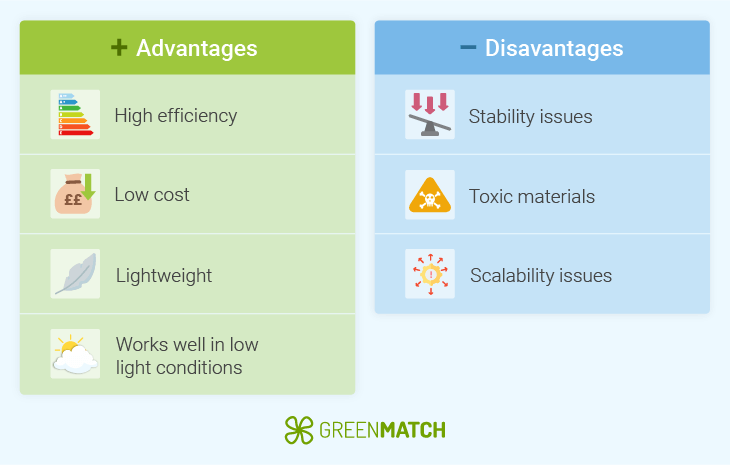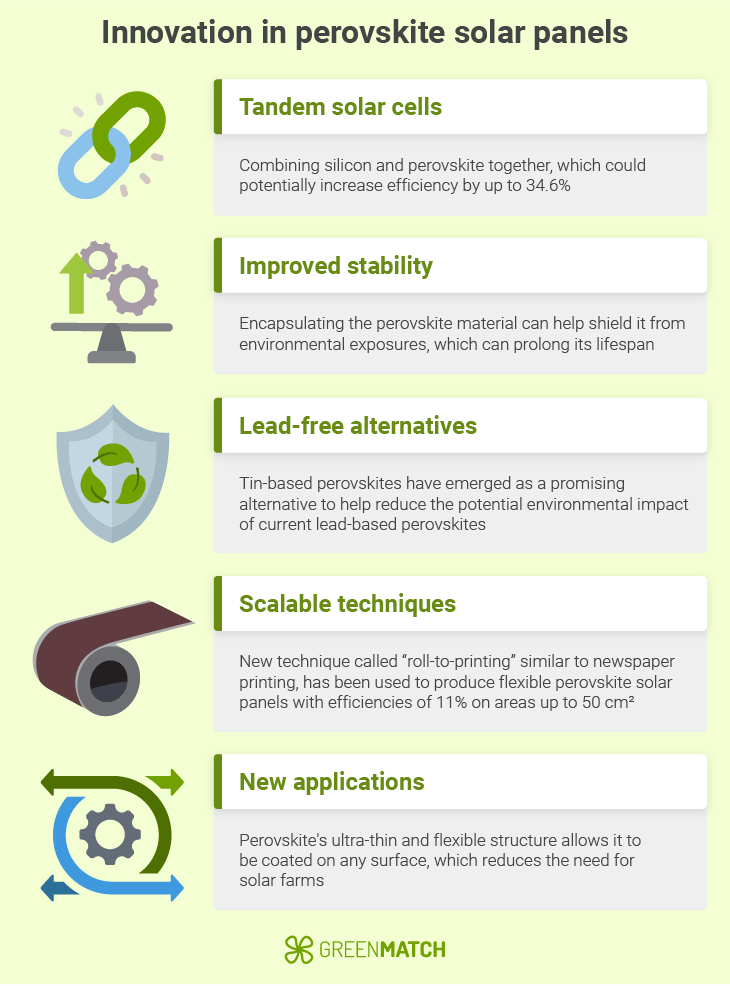Answer these simple questions and we will find you the BEST prices
Which type of solar quotes do you need?
It only takes 30 seconds
100% free with no obligation

Get up to 4 quotes by filling in only 1 quick form

Slash your energy bills by installing solar panels

For the average 2-3 bedroom house
- GreenMatch
- Blog
- Efficiency of Perovskite Solar Cells
Perovskite Solar Panels (UK): Efficiency, Pros & More


- Perovskite solar panels have achieved an efficiency rating of 25.7% compared to traditional solar panels, which have a rating of 20 to 22%.
- These solar panels have the potential to be 2 to 4 times cheaper than silicon solar panels as their material is cheaper to buy and cheaper to produce.
- The downside of perovskite is its durability, lasting only 2 to 3 years, compared to traditional solar panels, which can last up to 30 years.
Perovskite solar panels are the new buzzword in the solar industry at the moment. With potential to have an even higher efficiency rating than traditional solar panels, potentially being cheaper to produce and having the ability to be placed on different structures, perovskite is looking to be the future of clean energy.
While it is not yet available to the consumer market, the potential benefits of perovskite are attracting attention across the world. In this article, we will explore how these solar panels work, what their benefits are, and how efficient they can potentially be. We will also discuss what the future holds for their availability.
What are perovskite solar cells?
Perovskite solar cells are a new technological breakthrough for solar energy. The term "perovskite" refers to a group of elements (2 or more) that make up these new solar cells. This differs from traditional solar panels, which typically use "pure" silicone.
Perovskite solar cells are named after the mineral perovskite as they share a similar crystal structure. However, while the mineral perovskite is made of calcium titanium oxide (CaTiO₃), perovskite solar cells use a combination of different elements.
As they are a combination of elements, researchers can combine different elements to create new types. This includes metal oxide perovskites, used in fuel cells and metal-air batteries, according to MIT.
Metal-halide perovskites are most commonly used in perovskite solar cells as they have an amazing ability to absorb light while also having a thin structure. According to the U.S. Department of Energy, due to its light absorbing and thin abilities, perovskite can be stacked on top of another absorber layer, such as silicon, known as a “tandem” structure, which can further improve its efficiency.
While perovskite solar cells are currently not readily available, researchers believe that they hold a lot of potential to become the next generation of solar panel technology. Not only are perovskite solar cells potentially more efficient, but they have also been shown to have lower production and manufacturing costs.
How are perovskite solar panels made?

Perovskite solar panels manufacturing process is often simpler and more versatile than traditional silicon solar panels. However, according to Energy.gov, the technology is still in development, so the process can differ widely from researcher to researcher. Below is a general overview of how perovskite solar panels are made:
- Material creation: Precursor salts (used to create a chemical reaction) are mixed to form a perovskite ink solution.
- Substrate preparation: A base layer, which is usually made from flexible glass or plastic, is prepared and coated with a conductive material (which allows electricity to flow through it). Indium tin oxide (ITO) is the most commonly used conductive material in perovskite solar panels.
- Applying the electron transport layer: Next, a thin layer is applied to help electrons move efficiently. According to Ossila, materials such as titanium dioxide (TiO2) are used to help the electrons move.
- Perovskite layer applied: A thin layer of the perovskite ink solution is added to a base layer. The perovskite material is often applied to the base layer using a technique called spin-coating, which drops a small amount of the solution onto the base, which is then spun at a controlled speed. This allows the solution to evenly spread the base layer.
- Adding the hole transport layer: MDPI states that when an electron goes one way, the positive charge goes another. The hole transport layer helps guide these holes to the opposite electrode. Think of this as the return path for the current.
- Finishing with a top electrode: To complete the circuit, a final metal layer is added on top, usually gold, silver, or carbon. This layer collects the electric current and allows it to flow out of the solar cell so it can power devices or charge batteries
- Sealing: Perovskite is sensitive to water and oxygen so the entire panel needs to be coated in a protective seal. This step is crucial to help the panel last longer and work reliably outdoors.
While perovskite solar panels are simpler in their production, they are difficult to scale. According to NREL, it is difficult to manufacture layers uniformly, such as the hole transport layer, using a scalable method. There is still plenty of research and testing required in perovskite solar panel production to maintain its efficiency, enhance durability and ensure it is optimised for large scale production.
Perovskite solar panels efficiency
The main benefit of perovskite solar panels is their potentially higher efficiency. A 2022 study found that in the last several years, perovskite solar cell efficiency has increased from 3.8% to 25.7%. This rate of progress is unmatched by any other solar cell technology to date. This rate can possibly increase with more research applied to perovskite solar cell technology.
Traditional silicone solar panels typically achieve efficiencies between 20% to 22%. However, in ideal laboratory settings, they can reach up to 27%, according to the U.S. Department of Energy. However, these conditions are difficult to replicate in the real world, making this high performance challenging to achieve in practice.
One of the most promising aspects of perovskite solar panel efficiency is the development of tandem solar cells. A tandem cell combines a layer of perovskite and a layer of silicone to increase efficiency. According to PV Magazine, LONGi, a solar technology company, has achieved a record-breaking efficiency rating of 34.6% using tandem solar cells. This increase in efficiency shows the amazing potential perovskite has within the solar energy industry.
What are the pros and cons of perovskite solar panels?

Advantages of perovskite solar cells
- High efficiency: Perovskite solar cells have a conversion efficiency of 25.7%, rivalling traditional silicon solar cells with an efficiency rating of 20 to 22%.
- Low-cost manufacturing: According to the University of Michigan, perovskite solar cells could be 2 to 4 times cheaper than traditional solar panels. Perovskite can operate with imperfections and impurities in its structure, which makes it easier and cheaper to produce, unlike silicone, which requires high purity.
- Lightweight: Peroskite is more lightweight than silicon wafers, meaning that it can be potentially applied to different surfaces such as cars and infrastructure, potentially providing better solar energy without taking up vast amounts of space like traditional solar farms.
- Works well in low light conditions: Perovskite solar cells perform well in shady, cloudy and indoor environments as they can absorb a wider range of light wavelengths, according to Science Direct.
Disadvantages of perovskite solar cells
- Stability issues: The main issue with perovskite solar cells is that they are less durable than silicone panels as they are more susceptible to damage when exposed to oxygen, moisture and UV light. On average, they can last 2 to 3 years, according to Science Direct, while silicon solar panels can last between 25 to 30 years.
- Toxic materials: Many perovskite solar cells contain lead, which means if the panels are damaged, this toxic material can leak into the soil and water, according to a 2021 study. Additionally, Nature Connection explains that the lead in perovskites is more bioavailable, meaning that it can access our food chain much easier than other lead pollutants.
- Scalability issues: Perovskite solar cells are currently difficult to replicate on a large industrial scale as replicating high-efficiency and low temperatures is a complicated task, according to GreenLancer.
Comparison: perovskite vs. traditional solar panels
Perovskite and silicone solar panels have their own unique advantages and drawbacks. Below is a comparison table of the two:
| Perovskite vs. traditional solar panels | ||
|---|---|---|
| Feature | Perovskite solar panels | Silicone solar panels |
| Efficiency (Lab) | 25.7%, 34.6% in tandem solar cells | Up to 27% |
| Efficiency (real-world) | Still in development | 20 to 22% |
| Cost to manufacture | Potentially cheaper due to low cost materials | Higher, due to energy-intensive, high-purity silicon |
| Durability | Less durable due to sensitivity of moisture, UV and oxygen. Can last between 2 to 3 years | High durability, can last between 25 to 30 years |
| Flexibility | Can be lightweight, thin, and flexible | Rigid, typically mounted on rooftops or frames |
| Environmental concerns | Can contain lead which is damaging to the environment | Does not contain lead but currently has poor recycling facilities which contributes to landfill. |
| Integration with batteries | Can be integrated with solar batteries and inverters, just like traditional panels | Fully compatible with home energy storage systems |
Developments and innovations in perovskite solar panels

Perovskite solar panels have rapidly advanced since 2009, the first year perovskite was used in solar cell application, according to Science Direct. Through thorough research, the instability, performance and scalability of perovskite solar panels are quickly being overcome. Here are the recent developments and innovations in perovskite solar panels:
- Tandem solar cells: One of the most exciting developments within perovskite solar panels is the creation of tandem solar cells, which combine silicon and perovskite together, which could potentially increase efficiency by up to 34.6%
- Improved stability: A 2020 research paper showed that encapsulating the perovskite material can help shield it from environmental exposures, which can prolong its lifespan.
- Lead-free alternatives: According to Nature Communications, tin-based perovskites have emerged as a promising alternative to help reduce the potential environmental impact of current lead-based perovskites. However, research is still required to achieve the same efficiency and stability.
- Scalable techniques: A new technique called “roll-to-printing” has emerged in Australia and the UK in the production of perovskite cells. This technique, similar to newspaper printing, has been used to produce flexible perovskite solar panels with efficiencies of 11% on areas up to 50 cm², according to Physics World.
- New applications: According to Oxford University, the perovskite's ultra-thin and flexible structure allows it to be coated on any surface, which reduces the need for solar farms. TechRound has stated that perovskite solar cells have already been integrated into drone systems.
When will perovskite solar panels be available?
It is difficult to pinpoint the timeframe for when perovskite solar panels will be available to the average consumer. While they have enormous potential and promise, there are still several challenges that need to be overcome before they can be fully commercialised.
That said, the transition from the lab to the market is already underway, with industry experts believing they will be available on the market within the next few years. In fact, some companies have already taken the first steps. In 2024, Oxford PV began delivering tandem solar cells to the U.S. market. Additionally, Utmo Light, a Chinese manufacturer of perovskite, has initiated sales of its products in China and Japan, according to PV magazine.
However, despite these developments, durability and scalability remain one of the biggest challenges for the perovskite solar panel industry. But continued research and development are focused on overcoming these challenges. With continued research, development and innovation, perovskite solar technology is well on its way to playing a major role in the future of clean energy.
FAQ
Perovskite solar panels are a combination of different materials, such as elements, which form a crystal structure that efficiently absorbs sunlight.
On average, perovskite solar panels have an efficiency of 25.7%, while tandem solar panels (a combination of silicon and perovskite) have an efficiency of 34.6%.
They’re not widely available yet, as researchers are still working to improve their durability and scalability for commercial use.
They’re efficient, low-cost, and versatile but currently struggle with long-term stability and often contain toxic lead.

Caoimhe is an experienced content writer and researcher who is passionate about providing accessible information to every reader. With a background in English literature and Sociology, she combines the two disciplines to create cohesive, well-thought-out, and well-informed pieces.
We strive to connect our customers with the right product and supplier. Would you like to be part of GreenMatch?

- Perovskite Solar Panels (UK): Efficiency, Pros & More
- What are perovskite solar cells?
- Perovskite solar panels efficiency
- What are the pros and cons of perovskite solar panels?
- Comparison: perovskite vs. traditional solar panels
- Developments and innovations in perovskite solar panels
- When will perovskite solar panels be available?
- FAQ
Stay up to date with energy saving tips and grant alerts
Receive offers, marketing and promotions via email from Leads.io about GreenMatch and our brands/partners to help you save.
Thank you for subscribing to our newsletter!
Your email has been successfully added to our list. We look forward to sharing our latest updates with you soon!
